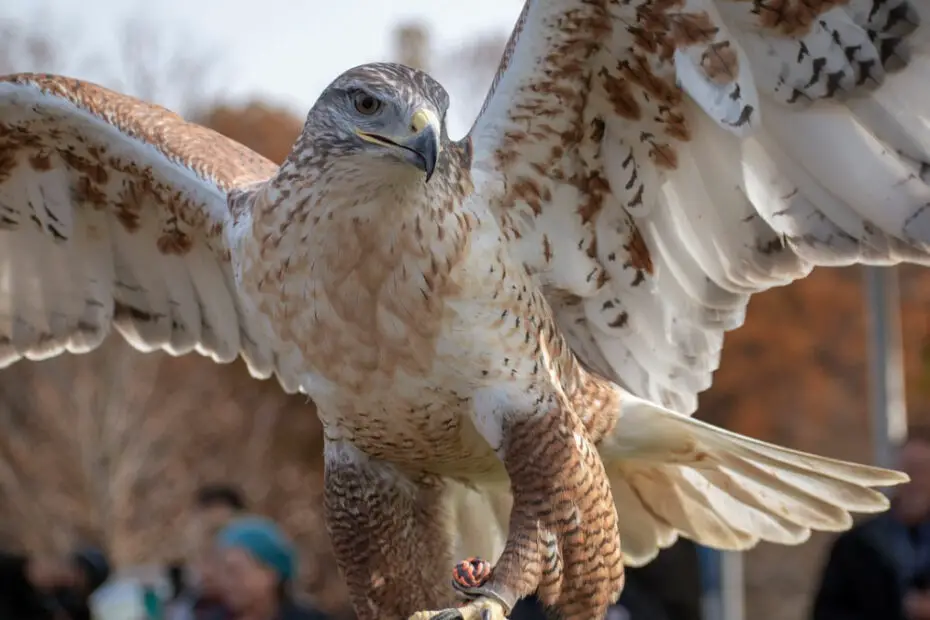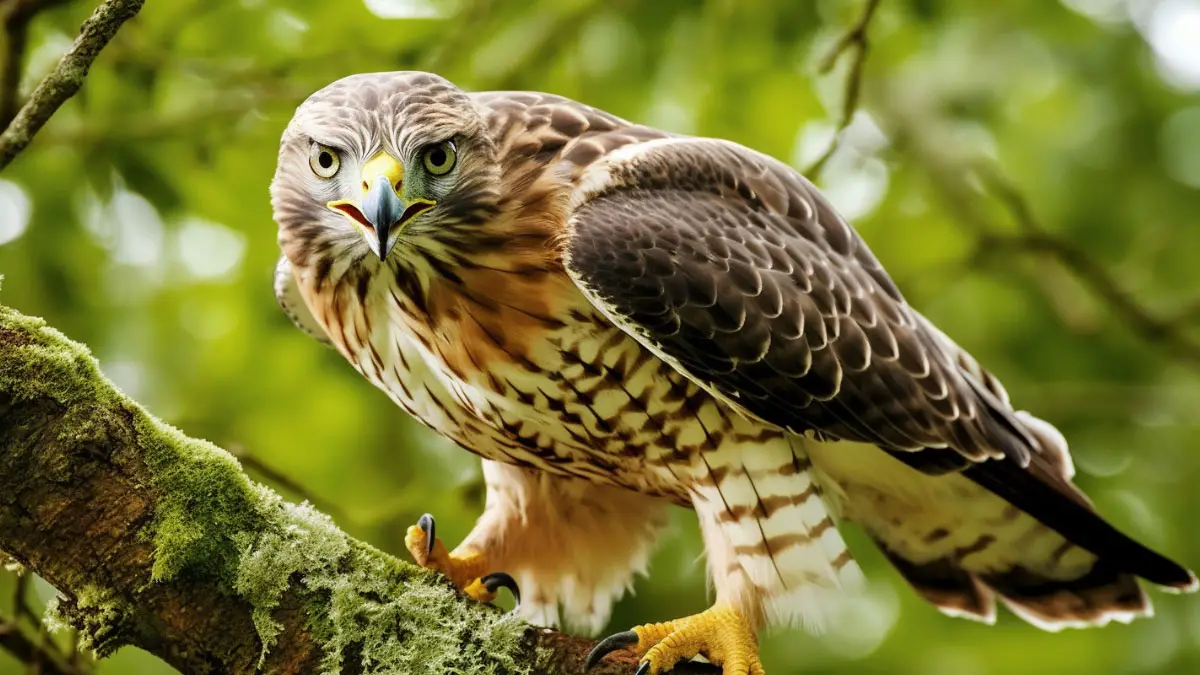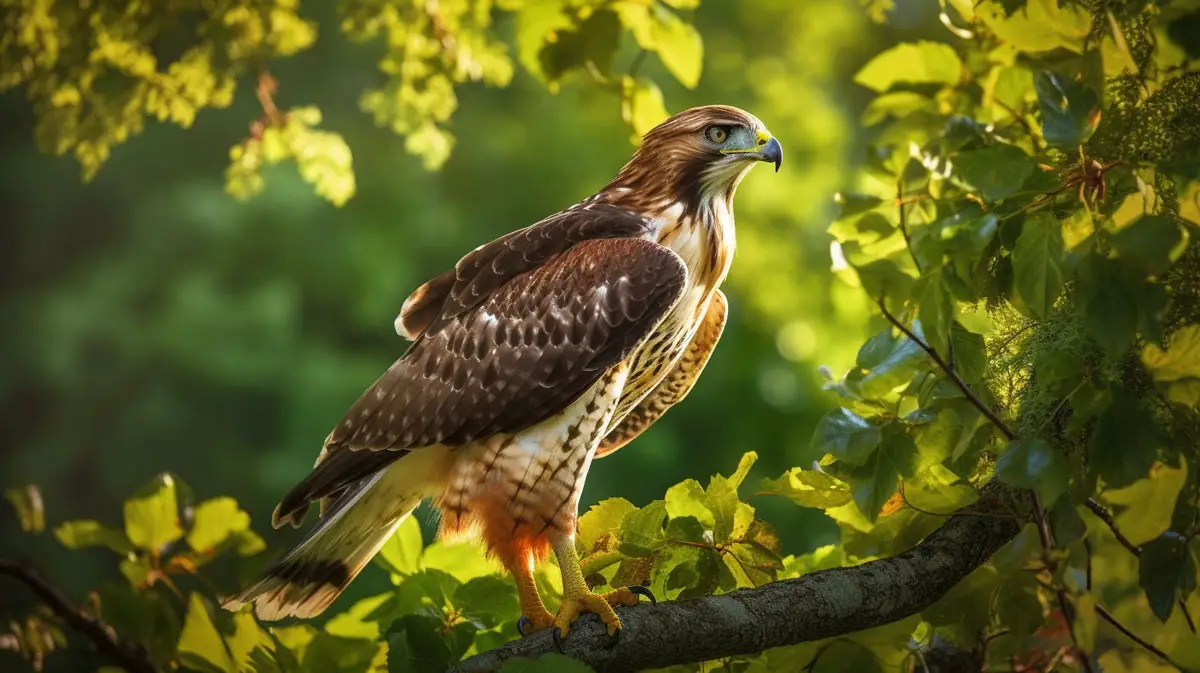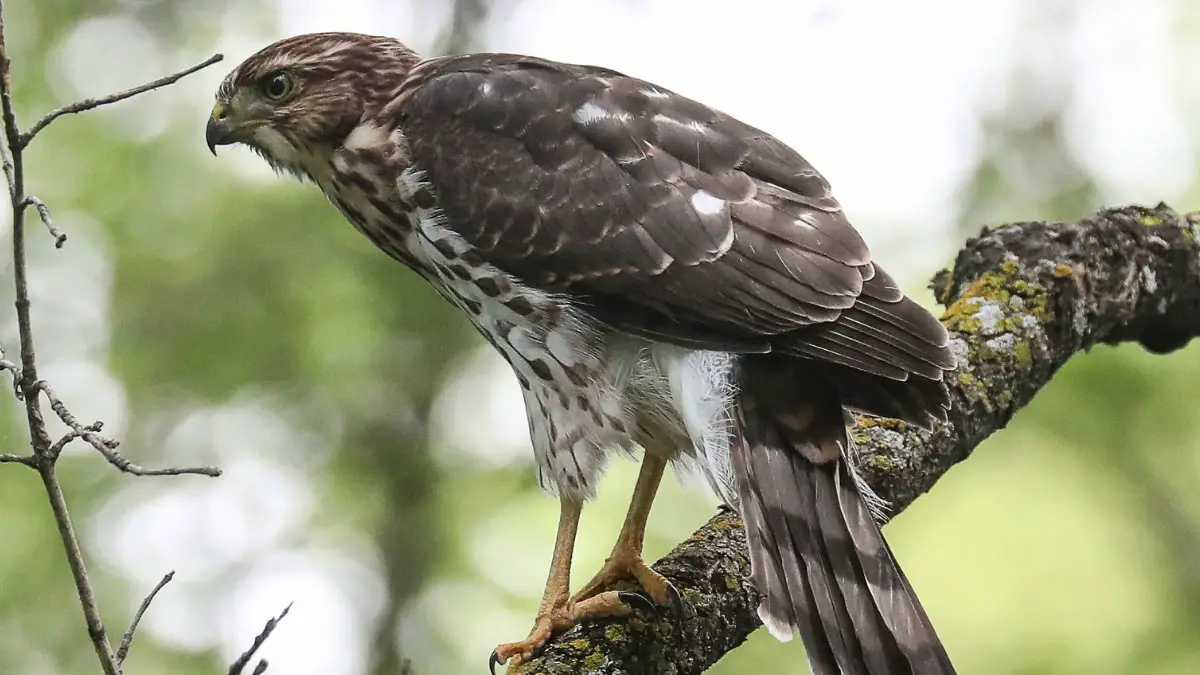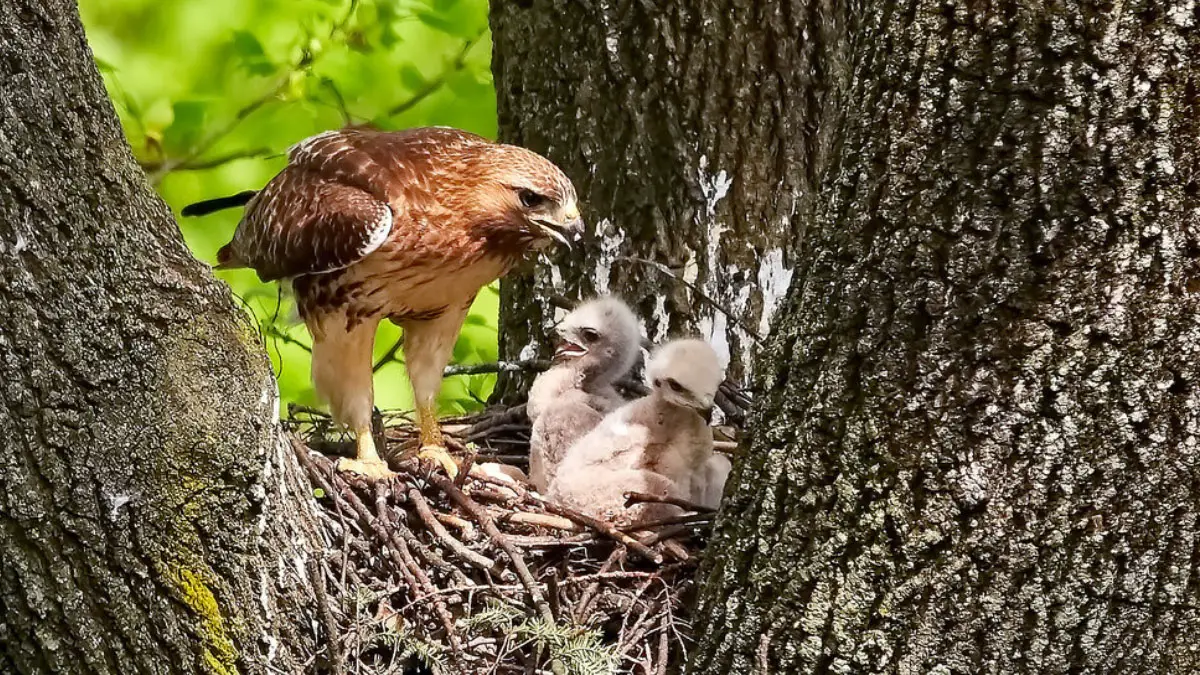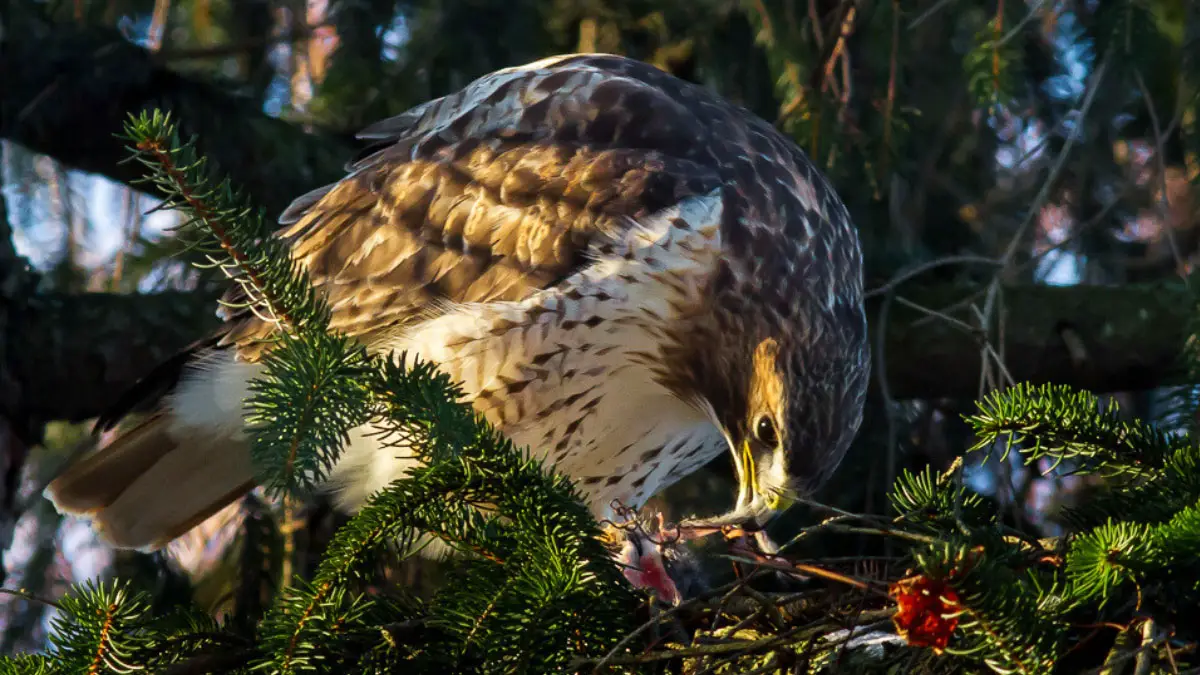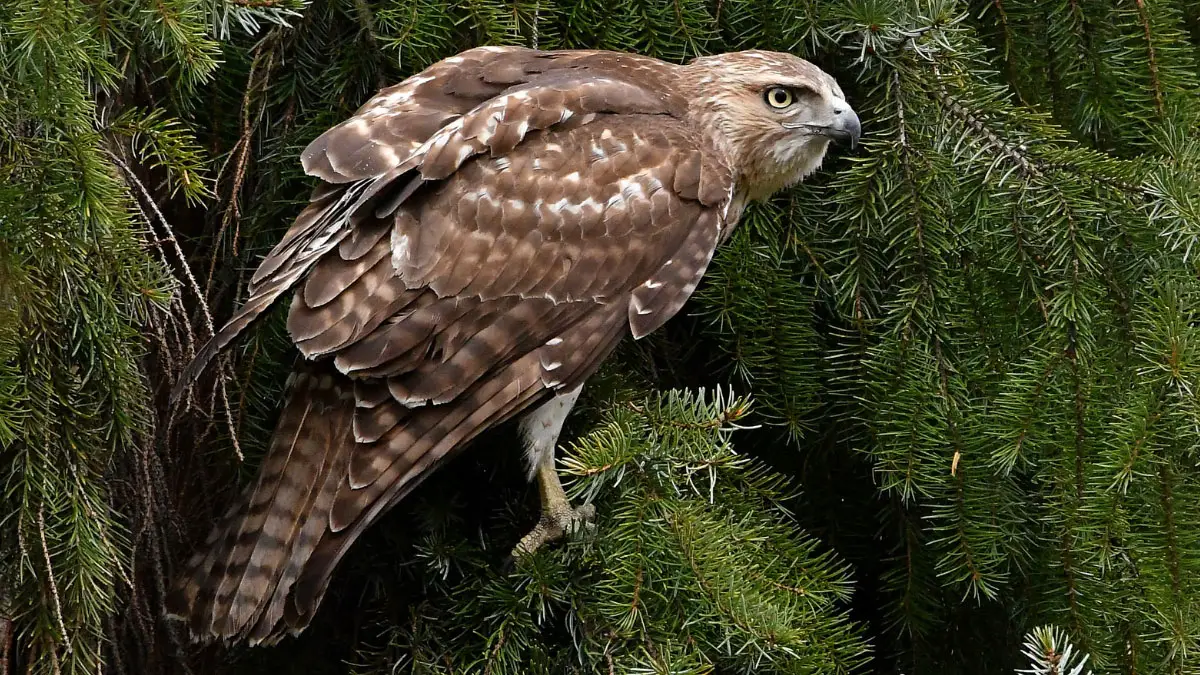Hawks are birds of prey found under the Accipitridae family, one of the three families under Accipitriformes. Of the 200-hawk species in the world, around 19 of them are in America.
Hawks are a crucial part of the ecosystem as they help regulate the population of small rodents, like voles, squirrels, gophers, mice, and rabbits. If these herbivores’ numbers increase, they can threaten the ecosystem by damaging crops and property and bringing diseases.
There are about 19 types of hawks in the United States, but some are more common than others. The common ones are the types you see around in almost any habitat.
Among these common ones includes the Red-tailed, Cooper’s, Broad-winged, Sharp-shinned, and Ferruginous hawks. All these birds can be observed in every state in any environment, from parks to urban centers. The physical characteristics of hawks differ with species and types.
The article covers five common types of hawks in the United States and explains their physical descriptions, habits, diet, mating, and more interesting facts. Therefore, read on.
Red-Tailed Hawk
Red-tailed hawk is one of the most common species of hawks found in the US. They hold the following characteristics for different aspects.
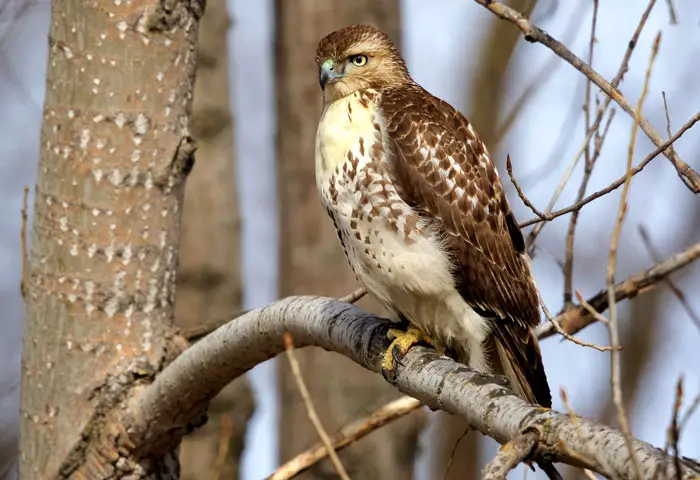
Physical Characteristics of Red-Tailed Hawk
Red-tailed hawks, as their name tells, have cinnamon red tail feathers that are pale from below. They come in a variety of colors from white to black and also bear different styles of markings. Therefore, other than the red tail, using these other features as hawk identification markers have proven challenging.
This bird of prey has a wingspan of four feet which is handy when soaring. The female can have up to 60 inches wingspan. Their height is between 18 and 24 inches for male and 19 to 26 inches for females, measured from head to tail. They can achieve speeds of up to 120 mph while diving.
An adult male Red-tailed hawk can weigh up to three pounds while the female gets up to 3.8 pounds. The juveniles have yellow eyes which turn to brown as they age. They have curved beaks with a sharp tip.
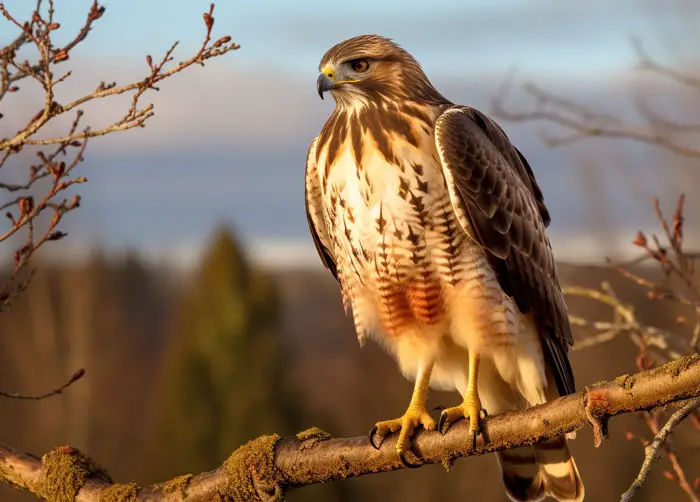
Habitats and Range of Red-Tailed Hawk
Red-tailed hawks are widely spread through the states and locations. They are in open country, woodlands, plains, prairie grooves, and mountains. They can be found in any habitat with high perches from where they can scan the prey.
There are also more populations of these hawks in different regions of the US. They are in most states and well adapted to the environments, including the urban centers.
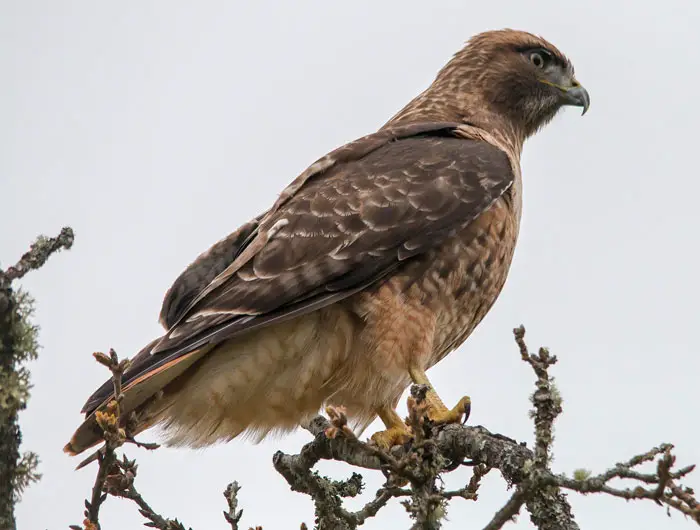
Diet Habit of Red-Tailed Hawk
Red-tails are predators and hunt on small rodents, but sometimes eat birds and reptiles, like snakes. Their diet varies with location and season, whereas those in areas with prey scarcity hunt more birds and reptiles. However, small mammals are the most preferred diet of hawks, including red-tailed hawks.
Their hunting strategy includes observing from a high perch, then diving and capturing prey with their sharp talons. Red-tail hawks also soar over hunting grounds and use their excellent sight to spot prey animals and swoop down and catch them.
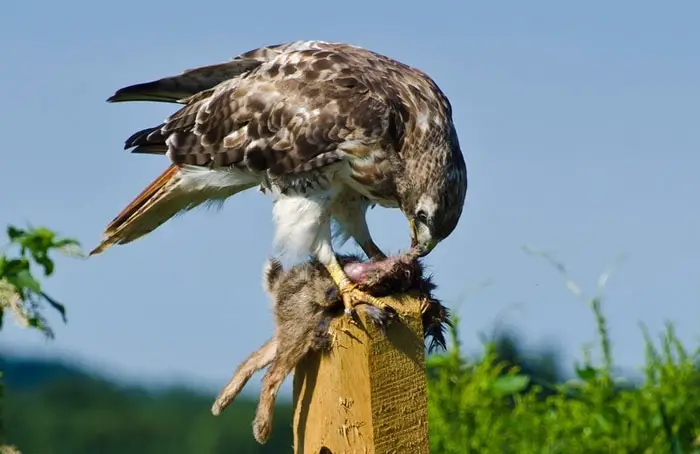
Mating and Nesting Habits of Red-Tailed Hawk
Red-tailed hawks reach breeding age when they are three years old. Their breeding season is spring, in March and May. These birds engage in aerial displays, make shrill cries, and preen each other during courtship which is among the many mating habits of hawks.
The birds then build a nest on tall trees using sticks, twigs, and barks. The clutch size is between 1-5 eggs. The breeding pair stays with their babies for at least 42 days after hatching, after which they become independent.
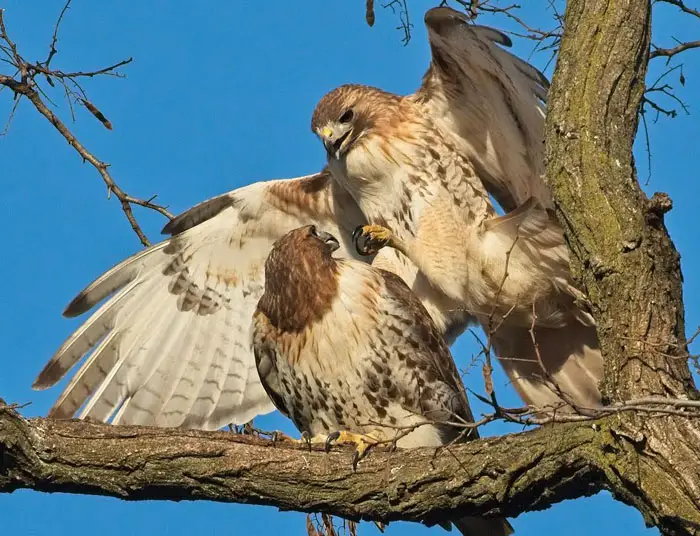
Interesting Red Tail Hawk Facts
The following are some interesting facts about Red-tailed hawks.
- Females are heavier than males by about 25%.
- Their diving speed can reach up to 120 mph.
- Their eyesight is eight times better than that of humans.
Cooper’s Hawk
Cooper’s hawk are also common hawks and have a stable population not only in America but also Canada and Mexico. Following are their different characteristics.
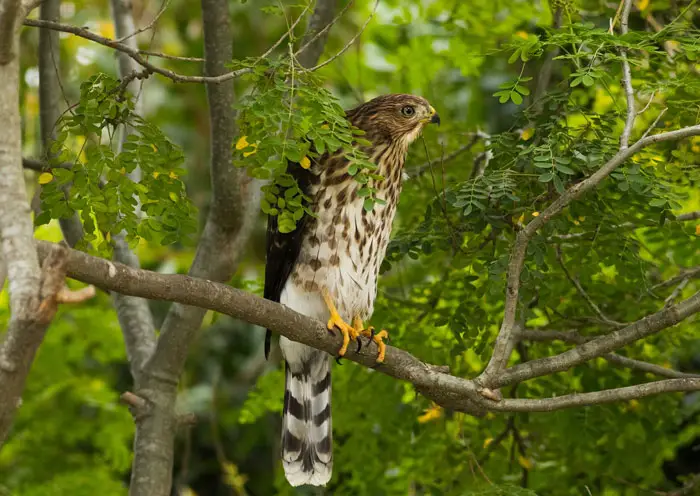
Cooper’s Hawk Physical Characteristics
Cooper’s hawks differ in body color and patterns when young and adults. They have brown upper parts contrasting with white underparts at a young age. Their upper parts are bluish-gray, and their underparts pale with reddish barring in adulthood.
Their bodies can be used for bird identification because of the markings. Also, their eyes are red as adults and yellow while young which can be used to tell their age. Their beaks are also curved with a sharp tip to tear apart prey.
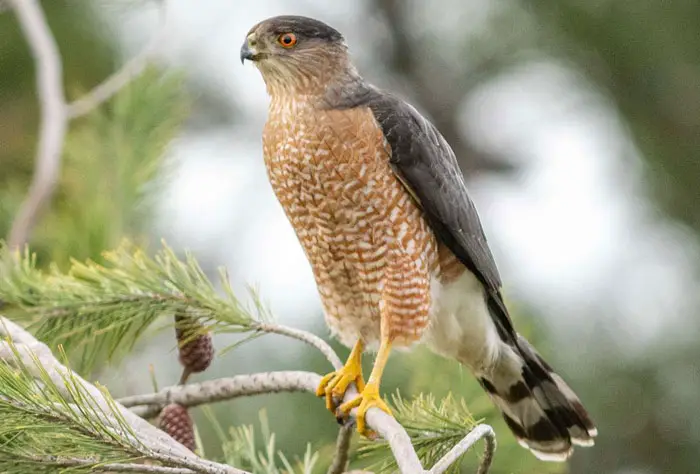
These birds’ wingspan ranges between 28 and 30 inches for males and 31-34 inches for females. The male size is between 14 and 18 inches and the females between 17 and 21 inches. A male can weigh between 0.6 and 0.9 pounds and a female 1.0 and 1.5 pounds. Their migratory speed is between 15-35 mph.
Habitat and Range of Cooper’s Hawk
Cooper’s hawks prefer forested areas, including deciduous forests, riparian woodlands, open woodlands, and forested mountainous regions. However, a study shows Cooper’s and sharp-shinned hawks occupy at least 67% of sites in Chicago urban areas which rose from 26% in 1990.
Cooper’s hawks are spread all over America, from Southern Canada to northern Mexico. This wide range is because they are short and medium-distance migrants during winter.
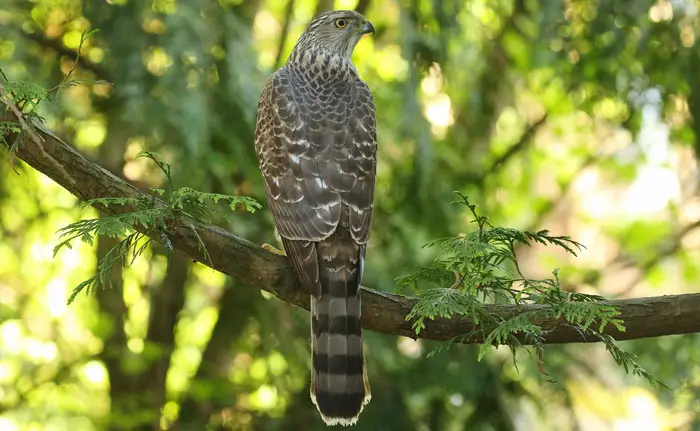
Diet and Hunting Habit of Cooper’s Hawk
Cooper’s hawks are known as swift hunters because of their skills in hunting. They majorly prey on medium-sized birds, like robins, jays, and flickers. However, they also feed on small mammals like squirrels, bats, mice, and chipmunks.
Cooper’s hawks’ hunting strategy includes perching and carefully watching and listening. After spotting prey, they fly swiftly and fast to intercept and catch it. They also take advantage of the bird feeders most bird lovers keep in their backyards. These hawks prey on the birds attracted to the feeders.
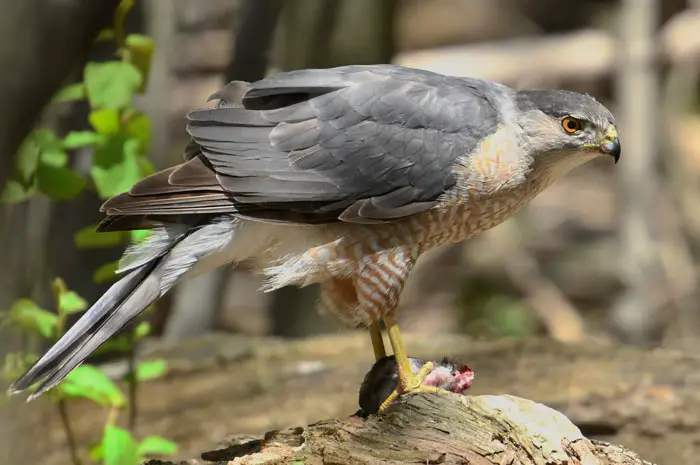
Mating and Nesting of Cooper’s Hawk
Cooper’s hawks’ mating age is two years, which is also when they secure territory. The courtship rituals include stylized flights with arched wings. After the courtship, the male selects a nest site, but the female does most of the building. Like most hawk species, Cooper’s hawks are monogamous.
They build their platform nest on trees, including pines and oaks, and use sticks and twigs to make it. The male hunts while the female incubates the eggs. The young grow fast and fledge within 32 days.
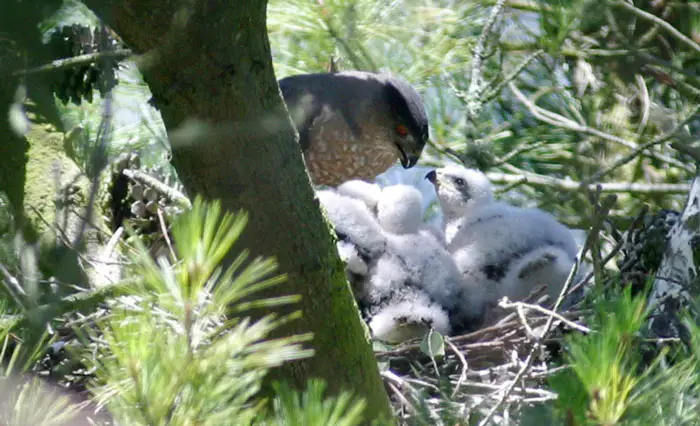
Cooper’s Hawks Interesting Facts
The following are some interesting facts about Cooper’s Hawks;
- Female Cooper’s Hawks are 20% longer and 30% heavier than males.
- Cooper’s hawks kill their prey by squeezing it repeatedly.
- These birds get their name from William Cooper, who collected their specimens in 1828.
Broad-Winged Hawk
Broad-winged hawks are another popular lot in North America with an approximate population of over a million birds. Here are their different characteristics.
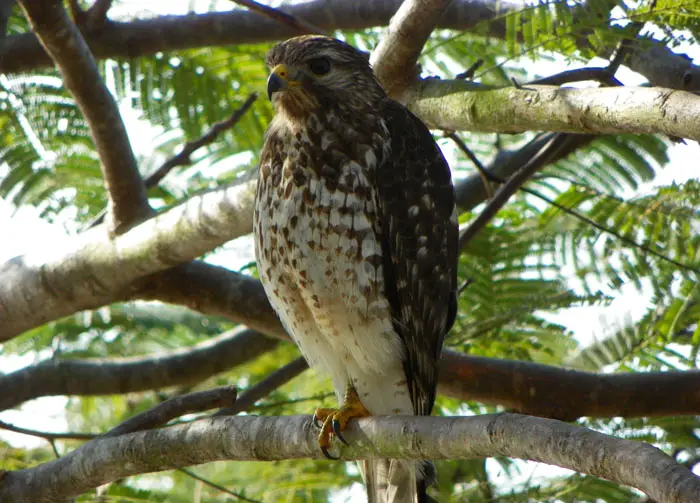
Broad-winged Hawk Physical Characteristics
An adult Broad-winged hawk has barred underparts, and their tails have broad black and white bands. The Juveniles have a lighter brown, and their tail feathers are narrowly banded. They are popular in lighter morphs, but there are rare dark morphs found in the West.
Note the color difference when identifying hawks by their markings, which usually differentiates age. Their eyes are yellow-brown as juveniles and turn dark brown as adults. Their beaks are scissor- like and curved and they can attain top speed of up to 40 mph.
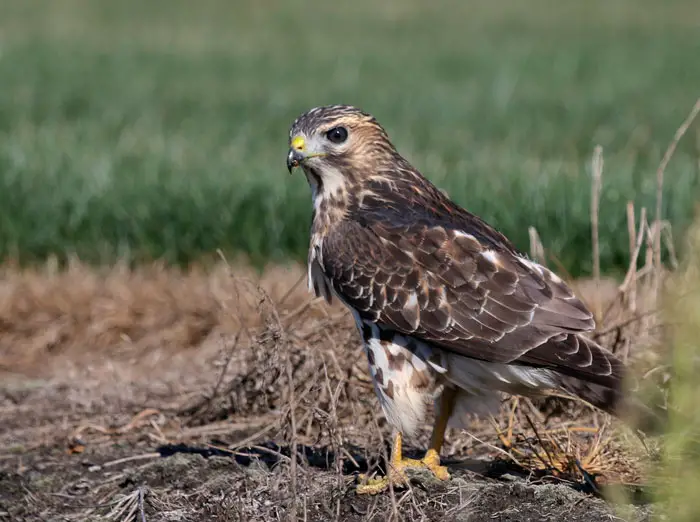
Broad-winged hawks are relatively small. The male size is between 13 and 16 inches, while the female ranges between 15 and 17 inches. The wingspan for the male is between 29 and 35 inches, and the female 34 – 39 inches. The male weight falls between 0.6 and 1.0 pound and 1.1-1.3 pounds for females.
Habitat and Range of Broad-Winged Hawk
Broad-winged hawks are found in dense, mostly unbroken deciduous or coniferous woodlands. They prefer living near water or clearing edges and tend to stay clear of other species’ habitats. They also tend to avoid human interactions.
These hawks often migrate to Florida and some northern parts of South America, but not all subspecies migrate. They migrate in flocks of over 40 birds and may reach up to thousands. In the American continent, they are found in most parts of North and South America.
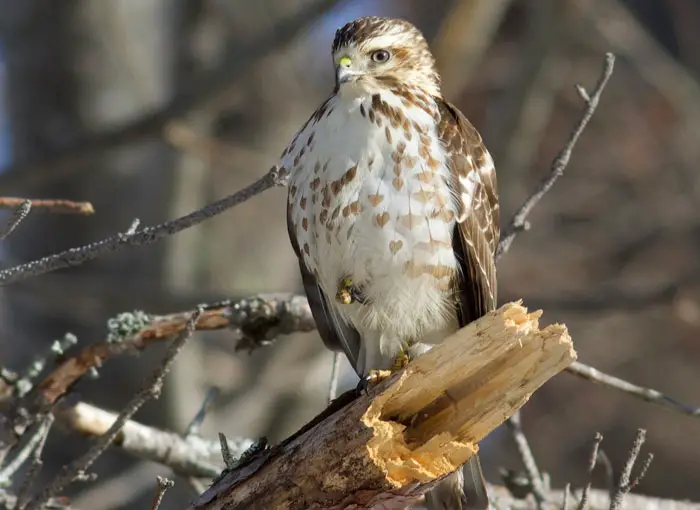
Diet and Hunting Strategy of Broad-Winged Hawk
Broad-winged hawks eat a variety of insects, reptiles, and mammals. Their food varies with season, but in spring they feed on voles, lizards, frogs, mice, and rabbits. During winter, they eat mostly insects, like grasshoppers, dragonflies, and reptiles, like snakes.
Their hunting strategy includes hiding in the foliage while watching out for prey. When they spot one, they swoop in and catch it with their sharp talons. Before feeding, a Broad-winged skins its mammal or reptile prey or plucks a bird prey’s feathers. Like most flight patterns of hawks, these birds use their broad wings to soar.
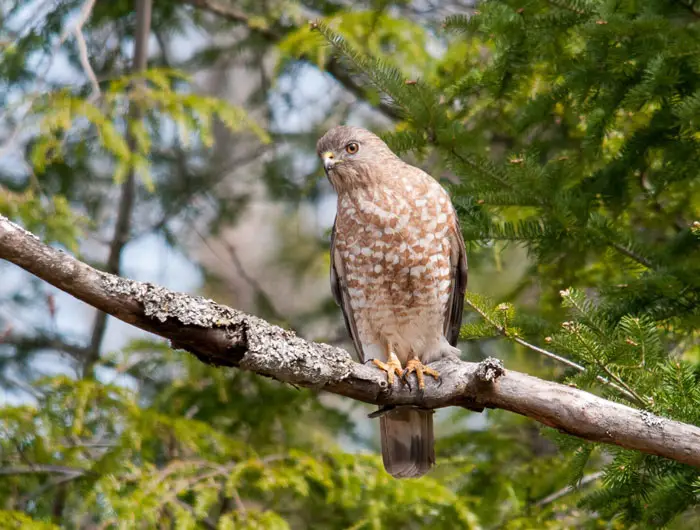
Mating and Nesting Habits of Broad-Winged Hawk
Broad-winged hawks reach maturity in two years, but some one-year-olds have been observed mating with older mates. The breeding season is between April and August, when the male makes whistling calls to advertise its territory to a potential mate.
The pair builds a nest on the lower parts of a tree using materials like sticks, and they use bark and moss to line it. Their clutch size ranges from 1 to 5, and incubation takes up to 31 days. By seven weeks, the chicks are grown enough to hunt and take care of themselves.
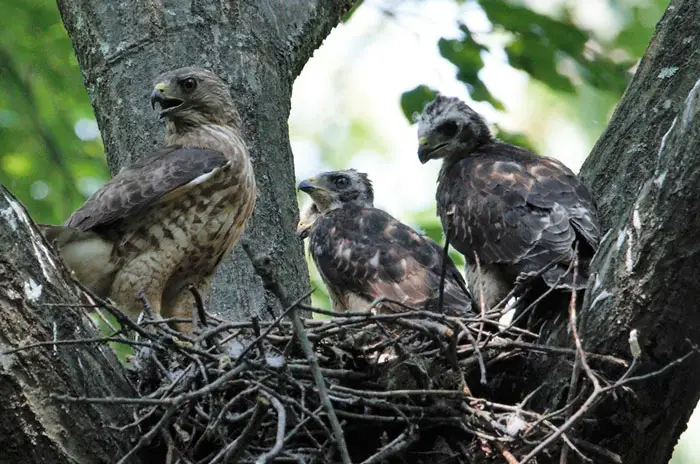
Interesting Facts about Broad-winged Hawks
Some interesting facts about broad-winged hawks include;
- They are called broad-winged because of their extended wing bone measuring between 8.9 and 11.8 inches.
- While they’re monogamous, some bonds only last for a breeding season.
- Broad-winged hawks can live for up to 12 years.
Sharp-Shinned Hawk
Sharp-shinned hawks are among the raptors recorded in numerous numbers at hawk watches during migration. Here are their various characteristics.
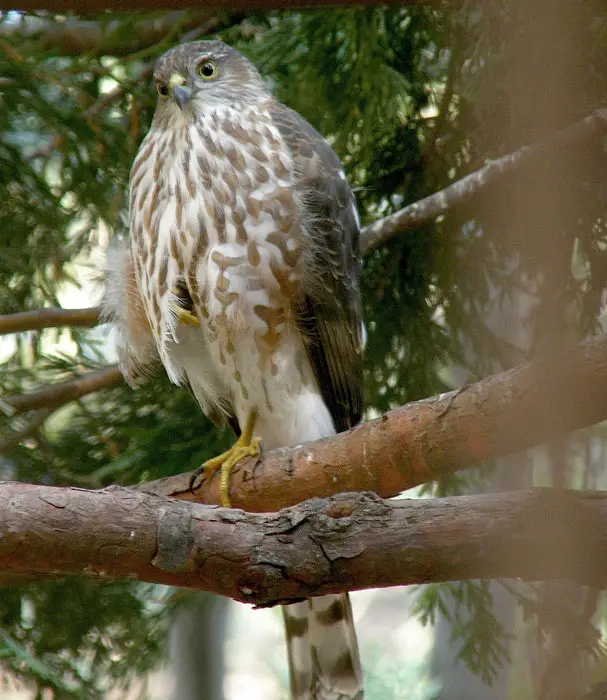
Sharp-shinned Hawk Physical Characteristics
Sharp-shinned hawks are small birds and adults are blue-gray on their backs and have horizontal red-orange bars on their breasts. Juveniles are brown overall and have yellow eyes. However, both have broad dark bands on their long tail feathers.
These birds have a small hook with a pointy tip. Their eyes are pale or yellow as juveniles and dark red as they age. They can achieve speeds of up to 60 mph while diving.
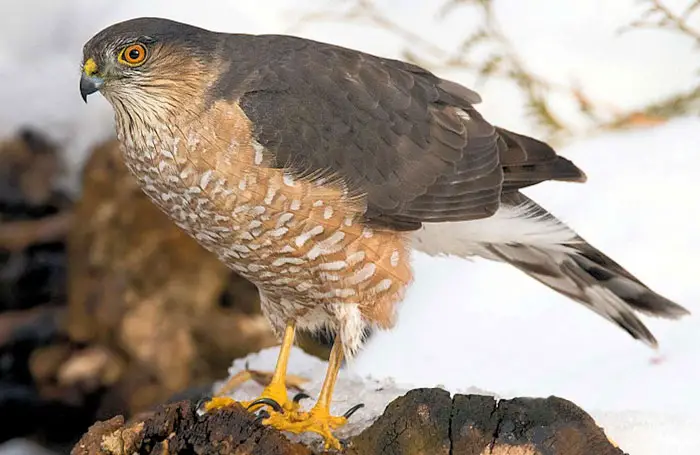
These predator birds weigh between 2.9 and 4.0 Ounces for males, and 5.3 and 7.7 ounces for the females. A male Sharp-shinned hawk’s wingspan is between 17 and 23 inches, and the females between 23 and 27. The male are smaller between 9 and 12 inches, while the females are 11 and 15 inches.
Habitat and Range of Sharp-Shinned Hawk
Sharp-shinned hawks are widespread in America and found on all continents. The nominate group is more common in North America, compared to the other three groups. Sharp-shinned hawk migration patterns put them to wintering grounds in south of Panama.
These birds live in mixed or coniferous forests and deciduous woodlands. They also favor brushy areas, especially in winter, but they tend to avoid the open country.
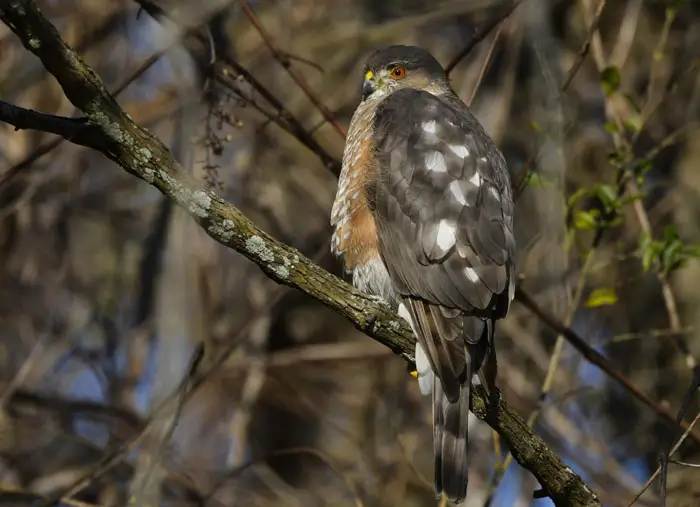
Diet and Hunting Habit of Sharp-Shinned Hawk
Sharp-shinned hawks mostly feed on small birds, like robins and songbirds, but sometimes, they also eat larger ones, like quail and doves. They also feed on small rodents, like bats, squirrels, snakes, and large insects, like grasshoppers, crickets, and dragonflies.
Sharp-shinned hawks are stealth hunters, among the common hunting strategies of hawks. These birds hunt by stealthily approaching prey under the cover of dense forest. They also hunt by perching and waiting for prey to approach, especially in a backyard with bird feeders.
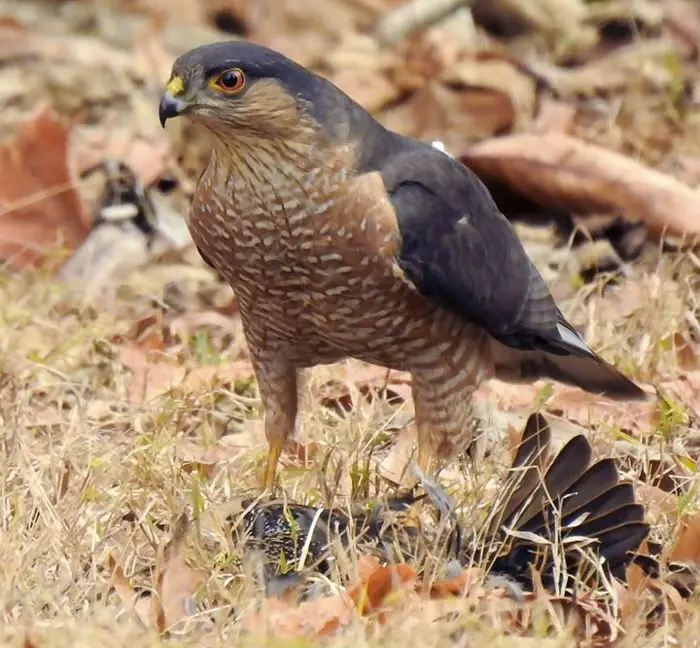
Mating and Nesting Habit of Sharp-Shinned Hawk
A sharp-shinned hawk’s breeding season is between late March and June when they migrate back from the wintering grounds. They reach maturity at two years of age, and their courtship rituals include aerial shows. Bird migration affects their nesting habits as they prepare late in the spring.
These small hawks build their nest on deciduous trees using twigs and line the inside with bark chips. The female lays four to five eggs, incubating for up to 35 days. The male provides the female with food for the first two weeks after their young hatch.
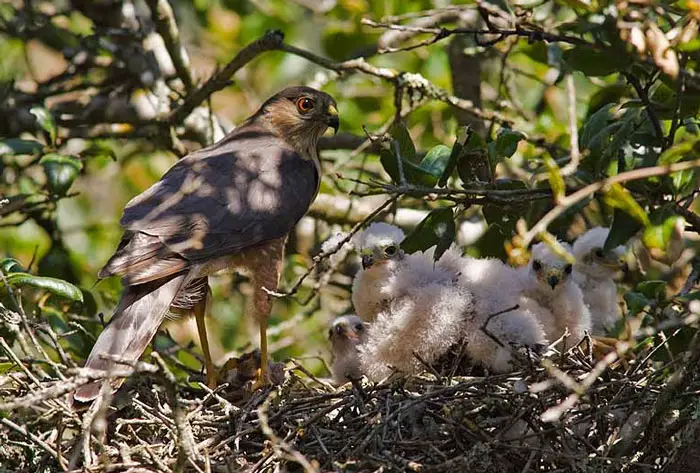
Interesting Sharp-Shinned Hawk Facts
Here are three interesting facts about sharp-shinned Hawks
- A female sharp-shinned hawk can weigh 50% more than a male
- Though sharp-shinned hawks are predators, they are prey birds to larger birds like Northern goshawks and Peregrine falcons.
- They get their name from their sharp keels.
Ferruginous Hawk
Ferruginous hawks are the largest hawks in North America. Below are their various characteristics.
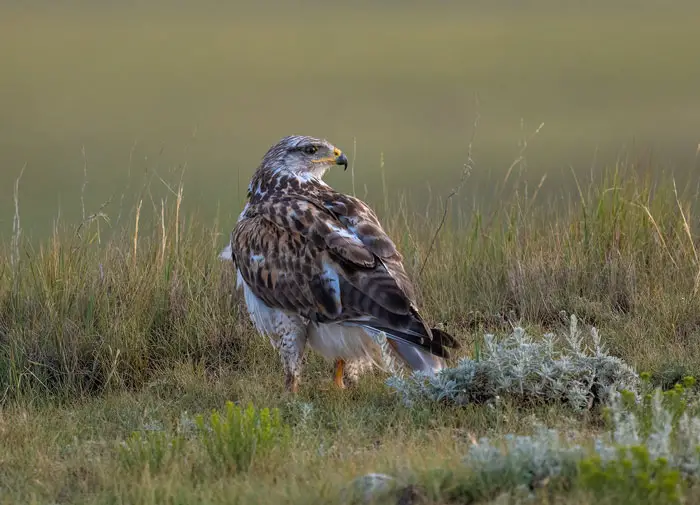
Ferruginous Hawks Physical Characteristics
These predator birds have a length between 20 and 24 inches for males and 23 to 28 inches for females. Their wingspan is between 48 and 57 for males, and up to 62 inches for some females.
The male weights range between 2.3 and 2.5, and the females 2.7 and 4.0 pounds. Their sizes almost get them confused with eagles, which leads to most hawks vs eagles questions.
Their eyes change from pale yellowish to dark brown as they grow. Ferruginous hawks have short, dark, and hooked beaks with a wide yellow gape. Their normal flight speed is between 20 and 40 miles per hour..
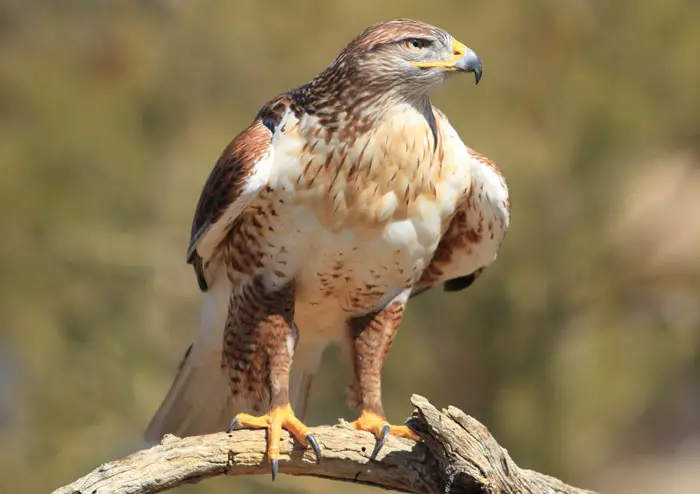
These large birds of prey have two morphs, the light, and the dark. The light morph is common, and individuals have pale heads and white underparts. Their upper parts are rusty, and if you do fancy bird watching, you can spot their legs forming a V when flying. The darker morph ferruginous hawks are deep rufous chocolate.
Habitat and Range of Ferruginous Hawk
Ferruginous hawks are among the US hawks that prefer arid and semiarid grasslands in North America, where countrysides are open and level. They also prefer sage brushes, steppe, scrublands, and woodland edges. However, they can also settle in agricultural areas, especially during migration.
These predator birds are found majorly in the western half of North America. They are in various states, including Washington, Arizona, New Mexico, Texas, and Nebraska. They are also in Canada, and during winter, they fly to Baja California and the central parts of Mexico.
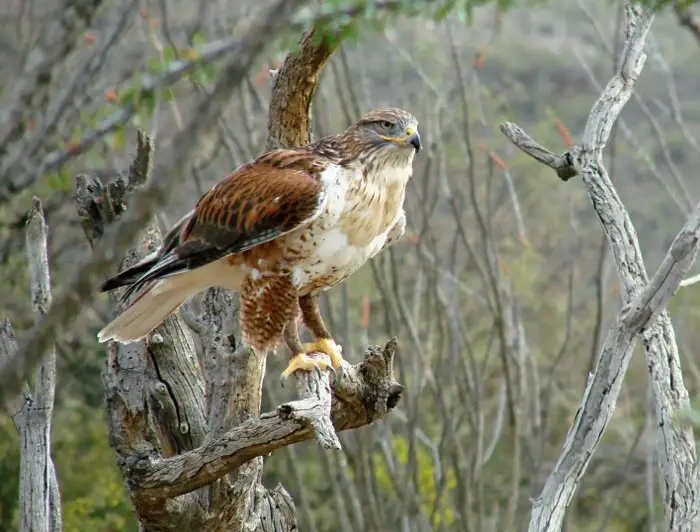
Diet and Hunting Strategies of Ferruginous Hawk
Ferruginous hawks feed on various types of prey, including reptiles, insects, and mostly small mammals. Some of their prey mammals include pocket gophers, Kangaroo rats, jackrabbits, and ground squirrels. They also feast on snakes and large insects like grasshoppers and crickets.
Since the hunting habits of hawks vary, the ferruginous hawk sometimes hunts by standing on the ground and running at prey. They also perch on nearby trees or posts where they dive on prey and catch it. However, the bird may also soar and scan for prey animals from high in the sky.
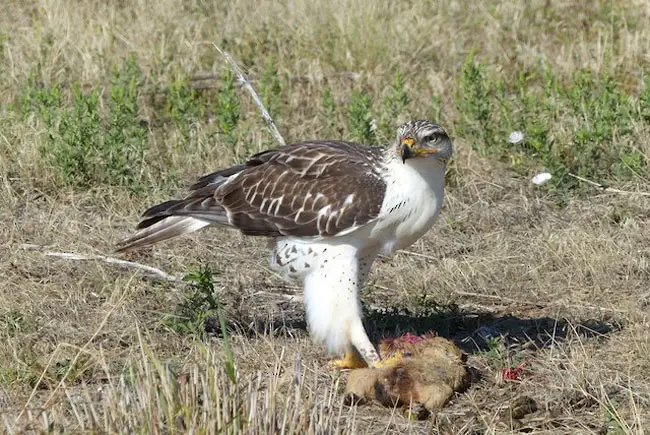
Mating and Nesting Habit of Ferruginous Hawk
Ferruginous hawks’ breeding season is in between March and April when they return from the wintering grounds. These birds are territorial and build their nest far from another breeding pair. The distance can be at least half a mile apart, but an ideal distance is at least a mile apart.
They build their nests on trees, hillsides, rocky outcrops, and also on the ground. The building materials include grasses, bones, horse dung, twigs, and roots, and both males and females participate in building. The female lays about four eggs and incubates them for about 25 days.
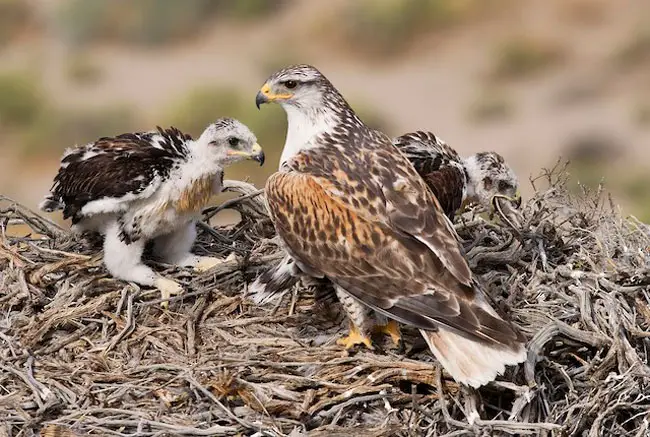
Interesting Ferruginous Hawk
Following are some interesting facts about ferruginous hawks.
- Their name ferruginous means rust-colored or reddish-brown.
- Ferruginous hawks can dive at speeds of up to 150 miles per hour.
- The bird can grind for up to 200 feet in one wing beat.
Endangered Hawks in the US
Despite the Hawks being on the top of the food chain, a lot goes on in their lives, and sometimes their survival is threatened. Studies show that twenty of the 200 species of hawks in the world are endangered.
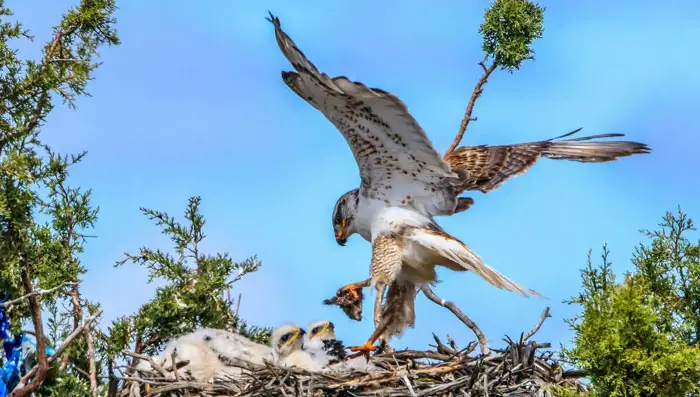
Some of the common threats to hawk survival in the United States include;
1. Deforestation
Most times, the loss of habitats where they usually breed and hunt is a reason for their population decrease. Forests are the common habitats of hawks, which is where they hunt and build nests. Human activities, like deforestation and urbanization, are among the reasons. While the nesting habits of hawks can change and adapt to the urban environment, most species cannot.
2. Pesticide poisoning
Before 1972, DDT used as a pesticide led to a decrease in the hawk population before being banned. A study on DDT effects on eggs shows that the eggshells get significantly thinner and lighter if a bird ingests DDT.
3. Poaching
Hunting by poachers who use these predator birds as trophies has increased the threat to their survival. Also farmers shooting, trapping, or killing hawks while protecting their domestic fowl, has led to endangerment.
4. Exposed power lines
Electrocution through exposed power lines is among the contributing factors to hawks’ population decrease. While the number of deaths cannot lead to the endangerment it’s a threat to their survival. Around 417 raptors were determined to have died from electrocution between 2000 and 2015.
Endangered Hawk Species In the US
Following are some endangered hawks in the US. Some are listed as endangered in their state rather than the whole country. However, since less is known of their population elsewhere, they require conservation efforts.
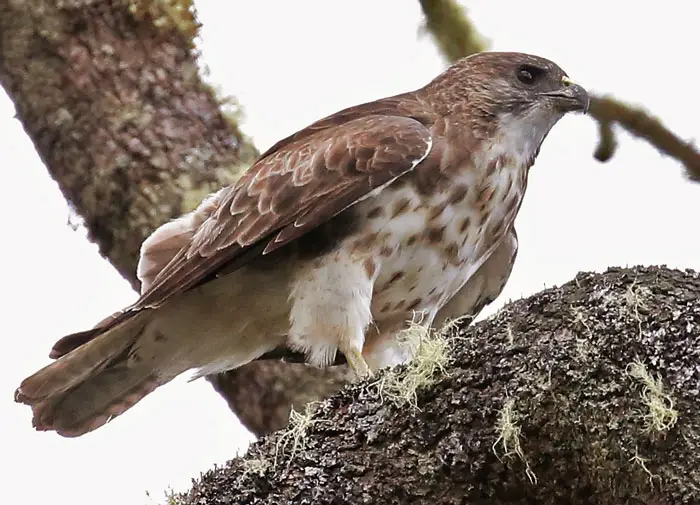
- Red-shouldered hawks – It’s believed fewer than 200 pairs breed in New Jersey.
- Hawaiian Hawk – According to IUCN Red List, the Hawaiian Hawk is rated as near threatened according to a 2016 report.
Conservation Efforts for The Endangered Species
The United States government has done a lot in conservation efforts for endangered hawks and other animals. First off, they raised a DDT ban, which could have wiped out populations of birds and mammals.
Also, federal protection minimizes occasions where hawks are shot by farmers and poachers. Coating the power lines is another conservation effort, which reduces death and injuries through electrocution.
Conclusion
After reading the article you should have a better understanding of the types of hawks in the United States. Since under each bird, their physical descriptions, habitats, diet, and mating habits are included, you get a better comprehension.
Hawks are crucial to the ecosystem as they keep the number of herbivores in check. Red-tailed, Cooper’s, Broad-winged, Sharp-shinned, and Ferruginous hawks are among the common types in the United States. Human activities, like deforestation and urbanization, have led to the endangerment of some species.
Learning and understanding different types of hawks is vital for research. This knowledge helps you understand various hawks and their environment, including their preferred habitats.
There is more to learn about these common hawks in the US, including more information on their habitats and diets. Learn more about them in research papers and blogs.
